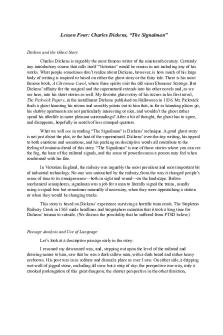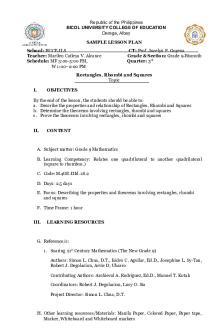Teacher Key Lesson 9 - worksheet PDF

| Title | Teacher Key Lesson 9 - worksheet |
|---|---|
| Course | Ecology |
| Institution | Philander Smith College |
| Pages | 3 |
| File Size | 85.4 KB |
| File Type | |
| Total Downloads | 41 |
| Total Views | 155 |
Summary
worksheet...
Description
Lesson 9 TEACHER Key to Student Activity Sheets
FOR USE WITH STEM TEACHING TOOL #29 stemteachingtools.org/brief/29
Bend Question: What explains what’s been happening to big animals in the Serengeti for the past four decades?
Lesson 9 ANSWER KEY FOR TEACHERS to Student Activity Sheets: Is there something special about wildebeest in the Serengeti? MODEL: 9. Draw a complete model of the Serengeti Ecosystem. Make sure to update your model since Lesson 7.
See Student Learning Objective final model and rubric.
These materials were developed with funding through grants from the National Science Foundation, the Gordon and Betty Moore Foundation, Denver Public Schools to Northwestern University and the University of Colorado Boulder.
This work is licensed under a Creative Commons Attribution 4.0 License http://creativecommons.org/licenses/by/4.0/
1
EVALUATE THE CLAIM: A keystone species is a plant or animal that plays an important and unique role in how an ecosystem functions. Without the keystone species, the ecosystem would be very different. One way scientists identify keystone species is to look at how changes to their abundance (number) affect other organisms. Often, there are many indirect effects of changes to the ecosystems. Use the space below to evaluate the claim that the wildebeest in the Serengeti is a keystone species. Draw on evidence you have gathered about the Serengeti to support your evaluation of the claim. 10. What evidence supports that claim?
The growth of the wildebeest population after the elimination of rinderpest led to big direct and indirect changes on the ecosystem. More wildebeest meant there was more food for their predators, such as lions and hyenas. The larger numbers of wildebeest meant there was less grass. They reduced the average height of grass in the plains by several inches. The lower grass levels meant less fuel for fires that periodically burned the plains. With fewer fires, the seeds of trees were allowed to grow, and eventually the plain became more covered with trees. This in turn led to a larger giraffe population. So, these direct and indirect effects led to big changes in the ecosystem, all because of the numbers.
11. What evidence contradicts or does not support that claim?
None that is presented in the bend as written. Not all ecosystems have keystone species, especially where there are multiple species where one could take the place of the keystone species if it were eliminated. Some evidence points to the fact that elephants are also keystone species in the Serengeti, though this was not explored in the bend.
2
LOOKING TO THE FUTURE: Some conservationists argue that the wildebeests should be protected on the Serengeti, even though the size of the wildebeest population is large, in order to protect the ecosystem in the future. Some local governments have sought to get rid of wildebeests in their countries, because the animals threaten livestock (e.g., cows) that people depend on to eat. 12. Would protecting the wildebeest help to protect the stability of the Serengeti ecosystem? Why or why not? It would likely protect the stability of the ecosystem, because of its outsized role in the ecosystem. There is no organism that is large enough to consume the amount of grass it does and that migrates across the plains, thus affecting both the plants it feeds upon and the numbers of predators that prey upon it.
13. Should governments give special protections to wildebeests? Why or why not? Even though the numbers are large, some argue that the government should protect wildebeest because it is a keystone species. If it were to disappear, the Serengeti ecosystem would change in a big way. Many of the predators there such as lions and hyenas could also disappear, radically changing the ecosystems. One reason not to protect them is that human population growth means that some of the Serengeti is needed to grow livestock for food.
14. What are some negative effects on other organisms in the ecosystems of your proposal? Protecting the wildebeest would result in less land being available for growing food for a growing population in Africa. Not protecting them could radically change the Serengeti ecosystem.
3...
Similar Free PDFs

Teacher Key Lesson 9 - worksheet
- 3 Pages

Lesson 9
- 6 Pages

Chapter 9 - KEY - Key
- 4 Pages

Worksheet 1 key - wksht key
- 2 Pages

Lesson 4 Dickens - Worksheet
- 3 Pages

141 Mole Worksheet Key
- 2 Pages

Dilations Worksheet Final KEY
- 6 Pages

Worksheet 02 Key
- 5 Pages

Worksheet 1a Answer Key
- 2 Pages

Newtons Laws Worksheet KEY
- 4 Pages

DNA Worksheet - KEY
- 1 Pages
Popular Institutions
- Tinajero National High School - Annex
- Politeknik Caltex Riau
- Yokohama City University
- SGT University
- University of Al-Qadisiyah
- Divine Word College of Vigan
- Techniek College Rotterdam
- Universidade de Santiago
- Universiti Teknologi MARA Cawangan Johor Kampus Pasir Gudang
- Poltekkes Kemenkes Yogyakarta
- Baguio City National High School
- Colegio san marcos
- preparatoria uno
- Centro de Bachillerato Tecnológico Industrial y de Servicios No. 107
- Dalian Maritime University
- Quang Trung Secondary School
- Colegio Tecnológico en Informática
- Corporación Regional de Educación Superior
- Grupo CEDVA
- Dar Al Uloom University
- Centro de Estudios Preuniversitarios de la Universidad Nacional de Ingeniería
- 上智大学
- Aakash International School, Nuna Majara
- San Felipe Neri Catholic School
- Kang Chiao International School - New Taipei City
- Misamis Occidental National High School
- Institución Educativa Escuela Normal Juan Ladrilleros
- Kolehiyo ng Pantukan
- Batanes State College
- Instituto Continental
- Sekolah Menengah Kejuruan Kesehatan Kaltara (Tarakan)
- Colegio de La Inmaculada Concepcion - Cebu




